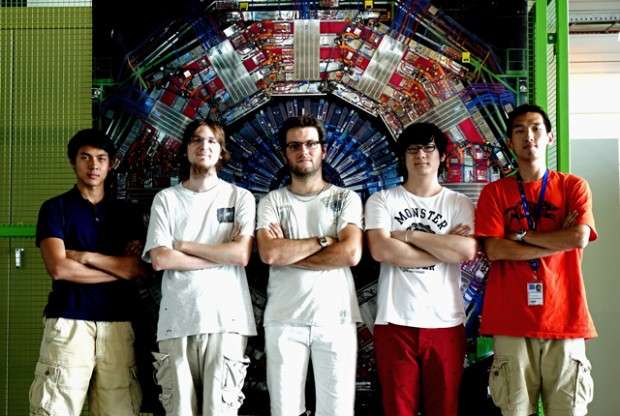Physicists find surprising 'liquid-like' particle interactions in Large Hadron Collider

Three years ago, Rice physicists and their colleagues on the Large Hadron Collider's (LHC's) Compact Muon Solenoid (CMS) experiment stumbled on an unexpected phenomenon. Physicists smashed protons into lead nuclei at nearly the speed of light, which caused hundreds of particles to erupt from these collisions. But that wasn't the surprise. What was surprising is where these particles went: Rather than spreading out evenly in all directions, the particles coming out of the collisions preferentially lined up in a specific direction.
Now, the Rice team has co-authored a paper that describes the unexpected particle interactions from these proton and lead-nuclei collisions.
Particle detectors are shaped a little like a soup can. In these kinds of collisions, there is a tendency for particles to amass in a line along the axis of the can known as a "ridge." Up until now, physicists understood a lot about what happens when a pair of protons or a pair of lead nuclei collide, but not a lot about what happens when a proton hits a lead nucleus: Would the hot nuclear matter coming out of the collision act like protons colliding, in which the post-collision particles coast along without feeling the effect of their neighbors? Or would the particles coming out of proton and lead collisions act in a more collective, liquid-like way as in lead-nuclei collisions?
In the recent Physical Review Letters paper, Rice physicists and co-authors returned to this mystery with more data than ever before. Physics Professor Wei Li, who discovered the phenomenon, led the team of scientists who analyzed the new data. They found that the data strongly supported that the matter coming out of these proton and lead collisions acts more like a liquid. This result was surprising because when the proton hits the lead nucleus, it punches a hole through much of the nucleus, like shooting a rifle at a watermelon (as opposed to colliding two lead nuclei, which is like slamming two watermelons together). Wei and his collaborators studied this surprising behavior by looking at six or eight particles simultaneously and how their directions correlated. This method is far more sensitive for identifying liquid-like behavior than the older method, which looked at particles two at a time. Li's group also developed an algorithm called a trigger that records a small number of important collisions in the CMS detector among billions of candidates, allowing the researchers to efficiently investigate this interesting phenomenon.
The data used in this analysis was recorded in March 2013 before the LHC stopped operations for refurbishments, retrofits and upgrades. This past June the LHC resumed operations with a 60 percent increase in collision energy. In December of this year, Li's group will reconfigure the LHC accelerator to collide lead nuclei and see what sort of surprises this increase in collision energy will bring.
This study helps scientists characterize a state of matter called a "quark-gluon plasma," or QGP. This is similar to the familiar solid, liquid and gaseous states of matter, but much hotter. A QGP occurs when matter is heated to temperatures high enough to literally melt protons and neutrons at the center of atomic nuclei; the last time that a QGP was common in the universe was a mere millionth of a second after the Big Bang. The liquid-like nature of the QGP was a surprise to scientists, as they predicted a more gaseous-like behavior. Learning more about quark-gluon plasma will teach us something significant about the birth of the universe itself.
More information: "Evidence for Collective Multiparticle Correlations in p−Pb Collisions." Phys. Rev. Lett. 115, 012301 – Published 29 June 2015. DOI: 10.1103/PhysRevLett.115.012301
Journal information: Physical Review Letters
Provided by Rice University



















